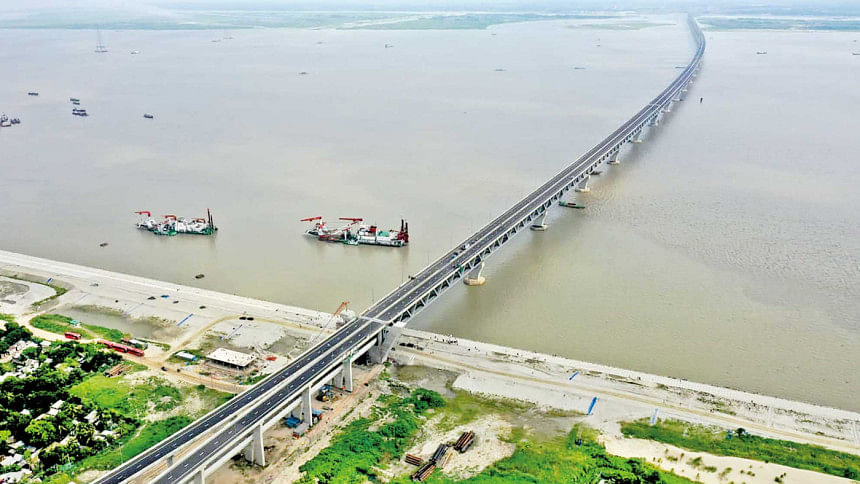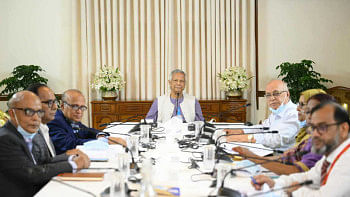“A transformational infrastructure”

The Daily Star (TDS): What possible changes could there be in our national transport system after the inauguration of the Padma Multipurpose Bridge?
Shamsul Hoque (SH): The Padma Bridge will be a transformational infrastructure for the development of Bangladesh. It will connect the country's south-western region with the capital. The ferry system had been quite unreliable, time-consuming and not cost effective. Padma Bridge will alleviate these long-standing issues and give the new streamlined connectivity a lot of mobility. This will also decrease waiting and travel times as well as traffic jams. Operational costs for businesses will also decrease as a result. It will be a huge boost to our economy.
TDS: For the first time, the southern part is going to be directly connected with the mainland, particularly the capital city of Dhaka. How do you look at this development?
SH: Definitely, there will be new changes to networks and infrastructure. Given that our country is riverine, split by Padma and Jamuna, there has always been a divide between the north and south. Padma Bridge bridges this gap, not just for businessmen, but for general citizens and small businesses as well. This will also establish a connection on the Asian highway. Padma Bridge will give us the infrastructural support to capture income from overseas and change the quantum of our economics, provided we can figure out the missing links.
Dhaka being capital city has always had a gravitational pull from other parts of the country. And there have always been many bottlenecks in the process of coming to Dhaka. Now that process is going to become much easier thanks to the bridge. Internal and local traffic of Dhaka is however set to increase due to a lack of readiness in the city's infrastructure in tackling the new influx of people coming to Dhaka via Padma Bridge. Dhaka needs distributional infrastructure changes for all of its entry points otherwise, the value of time added by Padma Bridge may become negated by the increase in congestion. The expected returns to the economy from Padma Bridge and the Dhaka-Mawa expressway can be made effective if roads and passages into the city are improved.
TDS: What is your take if you compare Padma Bridge with Bangabandhu Bridge regarding connectivity and economic potential?
SH: When the rails were connected to Bangabandhu Bridge, trains would move only at 20 kilometres per hour and a lot of the compartments were sometimes empty. In order to avoid this, Padma Bridge was designed with a functioning railway in mind from the start. With Padma Bridge we had a hand in ensuring its quality. It was not just a show of our own financial competence, but also a showcase of our mental and visionary focus. A lot of local expertise was taken into consideration when constructing the bridge. But it was still a project undertaken by foreign companies. It has been a learning experience and something that we can boast about and with big construction projects such as this, we now have a clearer idea about the process of undertaking such initiatives. And so, with proper guidelines, we can construct even better and through our own resources.
TDS: Roads of Khulna, Faridpur, Barishal remain two lanes but there is no doubt a vast number of vehicles are going to be plying them in the coming days, so what are the urgent concerns to mitigate this crisis?
SH: Planning and vision are imperative for development in any country. Similar to how Dhaka's system will struggle to cope with the excess traffic that will happen as a result of the opening of Padma Bridge, when people living in the northern and southern parts of the country can travel to any of its twenty-one districts, they have to take roads that do not have the capacity. We have to create four lane roads in that case and take care of building road networks where there is missing and lack of development. Similar to how people will respond to the effectiveness of time utilised while coming to Dhaka, they will draw the same parallel when traveling outside of it via the Padma Bridge. The development will then not be considered as being integrated. There is a huge opportunity to initiate inclusive economic growth by developing these parts of the country and by building strong roads. The government has to take action in developing these parts, otherwise unguided development may take place. Our production is increasing and it is a matter of importance for our internal capacities to come on par as well, in time for our graduation from a least developed country.

TDS: Which steps are necessary in order to keep Padma bridge safe in terms of maintenance, quick tolling system and fog in winter?
SH: The good news is that the health-monitoring system for Padma Bridge is really smart. The internal sensors can provide feedback on where the bridge may be damaged or distressed, allowing for the government to exercise preventive maintenance measures. This ensures longevity. The bridge must have variable message sign-based traffic information systems so that diversion policies can be taken by authorities in case of bad weather. While the time required to travel across the bridge has been advertised as being very short, we have to take into account the long lines of traffic at toll booths. Travel time, environment and sound pollution may increase because of the congestion of a lot of vehicles. Electronic toll plazas and prepaid solutions have to be considered so that vehicles can come and go through, suggestions which are rudimentary for development. With RFID and electronic license plates ensured by the government, this could be a good platform to test out the technology.
TDS: It is estimated that 8 per cent of vehicles will be added to the existing traffic in Dhaka once Padma Bride comes into operation. What would be the challenge to keep the capital city movable?
SH: Dhaka has a supply constraint, that is, there are few roads but an overabundance of vehicles. The problem is an urban one and when new people come into the city, it adds a new dimension to the issue. This is an issue that policy makers need to address in conjunction with the creation of the bridge. Another key oversight is the creation of a single-track rail-line instead of a double track one. This is a fault in planning and was a responsibility of the Planning Ministry that needed to be communicated with the constructing agencies.
TDS: Many housing estates are growing up in both adjacent areas of this bridge, which could create new problems on the linking roads. What should be focused on to avoid this problem?
SH: The focus should be on developing both the landscape surrounding the bridge and the bridge itself. But if people have already bought the land surrounding Padma Bridge, then the value of the land will become heavily inflated as time goes on. Road development does not happen with just developing and protecting the roads themselves, but also by making sure that the area around it is also protected. The government has to hold control of the land and area around Padma Bridge as well as developing destinations. The key is to ensure guided development.
TDS: What could be the future of our river transport system after Padma bridge?
SH: If you look at the toll rates you can assume that it will not be affordable for a lot of people. Plus, the destinations that Padma Bridge covers are not the same as the multiple ferry boats can connect to. So those who cannot afford to use the bridge can always use the alternative river transport systems. For example, overloaded trucks do not have to pay a hefty toll to use ferries but would have to worry about high toll rates of the Padma Bridge.
TDS: You are involved in the rail project of Padma Bridge. How can rail connection be effective in this project?
SH: The railways are essential for allowing people to travel to places they would have otherwise not gone to. Another key importance is establishing freight connectivity. With a new port on the horizon, freight services will be hugely important for business and commerce. This will allow for train services to also be profitable, as around the world, it is through profits from freight services that allow subsidisation for the passengers on trains. This focus is however not there. The new rail corridor on Padma Bridge will definitely cater to the citizens and bolster tourism, but it is important that container and freight movement logistic chains are also taken into consideration. This will greatly benefit the country's institutions and it can generate business-friendly development.
Dr. Md. Shamsul Hoque is a Professor at the Department of Civil Engineering, BUET.
The interview was taken by Priyam Paul.

 For all latest news, follow The Daily Star's Google News channel.
For all latest news, follow The Daily Star's Google News channel. 



Comments